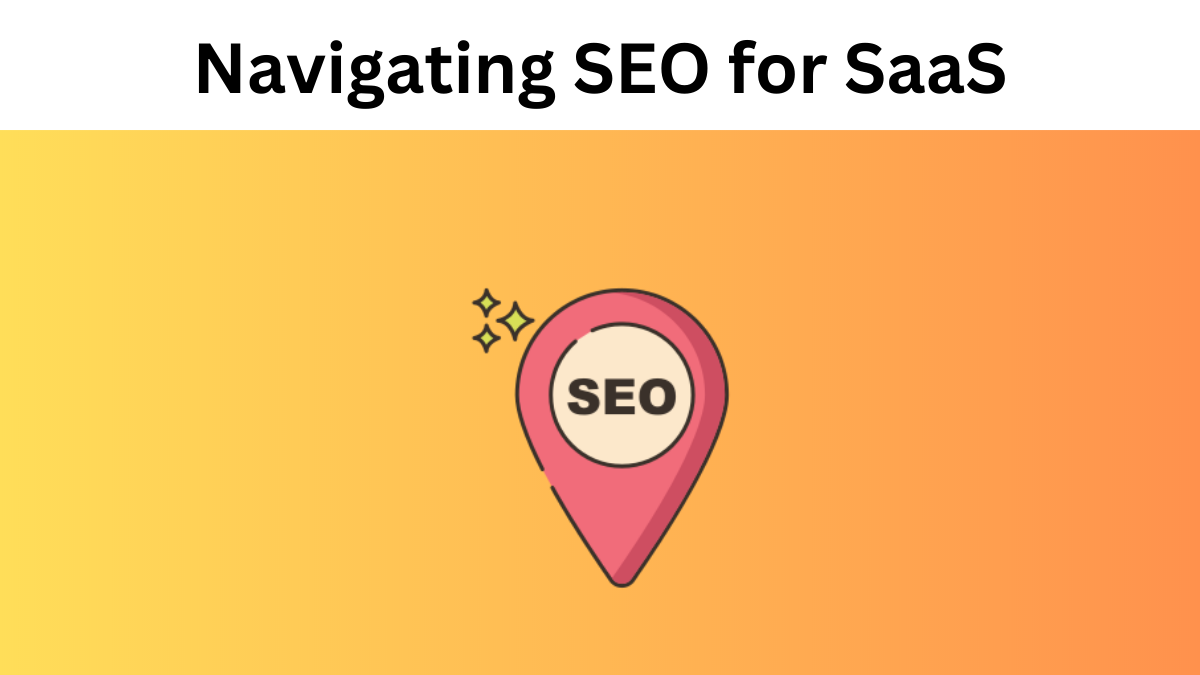Navigating SEO for SaaS in a GPT World: Essential Tips and Strategies
Welcome, explorer, to the ultimate guide on Navigating SEO for SaaS in a GPT World. And just like any explorer, discovering a new world is daunting and sometimes can get you lost.
Consider this your virtual compass to conquer the digital landscape, where search engine optimization meets the ever-evolving realm of social media pop culture. Like the hottest trending hashtags, we’re here to help your SaaS business soar to the top of the digital charts.
Contents
Let’s buckle up and adventure into the world of SEO in the age of GPT algorithms! 🚀
Understanding SEO in the Context of SaaS

When it comes to SaaS (Software as a Service), understanding SEO (Search Engine Optimization) is crucial to make your digital presence stand out amidst the vast sea of competitors. Imagine SEO as your secret weapon, empowering your SaaS offering to be discovered, favored, and trusted by search engines like Google, Bing, and Yahoo.
In this digital landscape, users rely heavily on search engines to find solutions, so you must optimize your website, content, and overall online strategy. SEO for SaaS entails techniques and strategies to enhance your website’s visibility and organic search rankings, ultimately driving more targeted traffic and potential customers to your virtual doorstep.
But what sets SaaS SEO apart from other industries? SaaS operates within a unique ecosystem, where the focus lies not only on selling a product but also on providing a valuable service that addresses customers’ pain points. The core principles of SEO need to be adapted and tailored specifically for SaaS businesses.
To navigate the intricacies of SEO in your journey, fellow explorers, start by understanding your target audience, identifying the keywords they use when searching for solutions, and optimizing your website accordingly.
Start your exploration by conducting thorough keyword research, mapping out relevant search terms, and strategically integrating them into your website’s content, metadata, URLs, and even your SaaS application.
Your journey continues by building a solid backlink profile will also establish your SaaS brand’s authority and credibility in the eyes of search engines. Leveraging content marketing, guest posting, and influencer collaborations can help you acquire high-quality backlinks that boost your search rankings and drive organic traffic.
Have you ever experienced a website with terrible design? Not a fun time. This is all about user experience, more commonly known as UX. It determines if your website is fast, mobile-friendly, and easy to navigate. Good UX improves your search rankings and enhances the user journey, and search engines prioritize websites that provide users with a seamless and engaging experience.
Content is king, and this line does not lie.
Creating valuable, informative, and engaging content that showcases your expertise, addresses user pain points, and highlights the benefits of your SaaS solution is vital. Incorporating relevant keywords, optimizing meta tags, and utilizing structured data markup can boost your content’s visibility in search engine results and drive organic traffic.
Last in your journey to SaaS success is staying updated with the latest SEO trends, algorithm updates, and industry best practices. As search engines evolve and GPT algorithms continue to shape the digital landscape, adapting your SEO strategies and leveraging emerging techniques becomes essential to maintain a competitive edge.
Understanding SEO in the context of SaaS is a game-changer. We’ll discover more about your journey in the following parts!
The Impact of GPT on SEO for SaaS: Opportunities and Challenges
With the emergence of GPT (Generative Pre-trained Transformer) algorithms, the world of SEO for SaaS has experienced a significant shift. GPT models, such as OpenAI’s GPT-3.5, have revolutionized how search engines understand and interpret user queries, content relevance, and search rankings. This AI-powered technology presents opportunities (but not without its unique challenges) for SaaS businesses looking to optimize their online presence.
GPT algorithms have improved search engines’ ability to comprehend the intent behind user queries, enabling them to provide more accurate and relevant search results. This development allows SaaS businesses to leverage long-tail keywords, natural language processing, and conversational search queries to better align their content with users’ needs.
Understanding the context and intent behind user queries can create targeted content that directly addresses user pain points, leading to higher search rankings and increased organic traffic.
Moreover, GPT models have enhanced search engines’ understanding of semantic relationships within the content, and search algorithms can now identify particular keywords and their broader context and meaning.
Now, SaaS businesses can focus on creating comprehensive, informative content that covers various aspects of their product or service, establishing themselves as authoritative sources in their niche.
However, the rise of GPT algorithms also comes with challenges for SaaS SEO. There is a growing need for SaaS businesses to differentiate themselves and provide unique value.
Competition with search engine-generated content means that SaaS companies must strive to create high-quality, original content that offers insights, solutions, and perspectives that cannot be replicated by algorithms alone.
GPT’s language generation capabilities emphasize optimizing content for voice search. As voice assistants and smart devices become increasingly prevalent, optimizing your SaaS content to align with voice search queries becomes essential.
Incorporating conversational language (make sure not to sound like a robot!), focusing on long-tail keywords, and structuring content to answer common voice search questions directly. By adapting to the changing landscape of search behavior, SaaS businesses can position themselves as the go-to solution for voice-enabled users.
SaaS businesses can also explore partnering with a specialized SaaS marketing agency to navigate these opportunities and challenges. Such agencies possess the expertise and knowledge to develop tailored SEO strategies, create engaging content, and optimize SaaS websites for maximum visibility and conversions.
If you seek professional guidance and support in optimizing your SaaS business for the GPT era, consider contacting a reputable SaaS marketing agency.
Essential Navigating SEO for SaaS in a GPT World

Okay, explorer, it’s time to get down to the nitty-gritty. The challenges involved will not faze you in your journey with the tips you need to get started below.
Conducting Keyword Research
Keyword research is fundamental in optimizing your SaaS website and content for search engines. In a GPT (Generative Pre-trained Transformer) world, understanding the right keywords and search terms used by your target audience becomes even more critical.
Conducting thorough keyword research can uncover valuable insights and optimize your SaaS offerings to align with user intent.
Keyword research involves identifying the specific words and phrases your potential customers use when searching for solutions for your SaaS product or service. This helps you understand the language and terminology used in your industry, so you can match your content with user expectations and improve your search rankings.
To conduct keyword research effectively, start with the following steps:
- Looking at Gen-Z? Define who you’re talking to, A.K.A., your target audience: Identify your target audience’s demographic, interests, and pain points. This understanding will help you generate relevant keywords that resonate with your potential customers.
- What would they Google? Memes and Reddit posts, anyone? Use keyword research tools: Utilize various keyword research tools like Google Keyword Planner, SEMrush, or Moz Keyword Explorer to discover relevant keywords related to your SaaS offering. These tools provide valuable insights into search volume, keyword difficulty, and related keywords that can inform your optimization strategy.
- Long-tail keywords are longer, more specific keyword phrases with lower search volume but higher intent. They often indicate users who are closer to making a purchasing decision. Incorporate long-tail keywords into your content to attract highly targeted traffic and increase your chances of conversion.
- Analyze competitor keywords: Study the keywords used by your competitors who rank highly in search results. This analysis can give you insights into effective keywords and opportunities for differentiation.
- Are they looking for memes for fun? Check user intent: Understanding the purpose behind each keyword is crucial. Users may be searching for information or solutions or looking to purchase. Align your content with user intent to provide relevant answers and solutions.
- Monitor and adapt (not every meme will be viral!): Keep track of your keyword performance and adjust your strategy accordingly. Monitor changes in search trends, user behavior, and industry developments to stay ahead.
Not everything’s a one-hit-wonder.
Conducting effective keyword research is an ongoing process. Stay up-to-date with industry trends and search algorithm updates to refine your keyword strategy and ensure your SaaS offering remains optimized for search engines.
Optimizing On-Page SEO
Knowing what Gen Z memes are being Googled now is a must, but so is being the first meme they see!
Optimizing on-page SEO influences the visibility and ranking of your SaaS website in search engine results. On-page SEO involves optimizing various elements on your web pages to make them more appealing and relevant to search engines and users.
To start optimizing on-page SEO, here are some practices you can do:
- Craft Relevant and Engaging Content: Develop high-quality, informative content that addresses your target audience’s pain points and needs. Incorporate your target keywords naturally throughout your content while ensuring it flows organically.
By providing valuable and engaging content, you increase the likelihood of attracting and retaining users, improving their overall experience, and increasing the chances of earning backlinks and social shares.
- Optimize Meta Tags and Descriptions: Meta tags and descriptions are HTML elements that provide concise information about your web pages to search engines and users. Optimize these elements by including your target keyword and crafting compelling descriptions that entice users to click through to your website.
Well-optimized meta tags and descriptions improve the visibility of your pages in search results, increasing the chances of attracting organic traffic.
- Enhance User Experience (UX) and Page Speed: Ensure your website is user-friendly, easy to navigate, and mobile-responsive. Optimize your website’s design, layout, and navigation to provide a seamless user experience.
Additionally, improve your website’s page speed by optimizing image sizes, minifying CSS and JavaScript files, and leveraging browser caching. Fast-loading pages improve user satisfaction, reduce bounce rates, and positively impact search rankings.
Build High-Quality Backlinks
You trust friends and family for references, right? Well, the same goes for SEO. You gain credibility when other pages reference you.
Building high-quality backlinks is an off-page SEO strategy demonstrating your SaaS website’s authority and credibility to search engines. Here’s how:
- Guest Posting and Influencer Outreach: Guest posting involves writing and publishing articles on external websites relevant to your SaaS niche. Look for reputable websites and blogs that accept guest contributions, and provide them with valuable and unique content.
Include an appropriate link to your SaaS website within the article or author bio, which can drive referral traffic and improve your search rankings. You can also reach out to influencers and thought leaders to create content or request them to mention or link to your SaaS solution. Influencers’ endorsements can significantly boost your brand’s visibility and credibility.
- Leveraging Social Media for Link Building: Social media platforms provide link-building opportunities and increase your SaaS website’s visibility. Share your valuable content, blog posts, and resources on social media channels to generate engagement, attract potential customers, and encourage social sharing. Engage with your audience by participating in industry discussions and relevant online communities.
This engagement can lead to organic sharing and potential backlinks. Additionally, consider contacting relevant social media influencers or bloggers and asking them to share or link to your content. Their endorsement can bring valuable traffic and backlinks to your SaaS website.
Maximizing Local SEO
Mr. or Mrs. Right isn’t always easy to find; the same goes for customers.
Maximizing local SEO can help attract the right customer if your SaaS business targets a specific geographic location. Here are effective ways to maximize local SEO:
- Creating Location-Specific Landing Pages: Creating location-specific landing pages allows you to target local keywords and tailor your content to the needs and interests of users in specific regions. Develop dedicated landing pages focusing on each target location, incorporating location-specific keywords, such as the city or region name, in your page titles, headings, and content.
Provide valuable information about your SaaS solution’s benefits for users in that location, addressing local challenges or preferences. This targeted approach helps improve your visibility in local search results and increases your chances of attracting qualified local traffic.
- Encouraging Customer Reviews and Testimonials: Customer reviews and testimonials play a significant role in local SEO. Positive reviews build trust and credibility and contribute to your local search visibility. Encourage satisfied customers to leave reviews on relevant platforms such as Google My Business, industry-specific directories, or social media platforms. Respond to positive and negative reviews to engage with your customers and show that you value their feedback.
These reviews and testimonials provide social proof to potential customers and can influence their decision-making process, leading to higher conversions and improved local search rankings.
Conclusion
Navigating SEO for SaaS requires a strategic approach that adapts to the evolving digital landscape. As a new explorer of this world, understanding the impact of GPT on SEO for SaaS can help you identify opportunities and challenges.
Conducting thorough keyword research, optimizing on-page elements, building high-quality backlinks, and maximizing local SEO can also improve visibility, attract targeted traffic, and drive conversions.
Crafting relevant and engaging content, optimizing meta tags, enhancing user experience and page speed, leveraging guest posting and influencer outreach, utilizing social media for link building, creating location-specific landing pages, and encouraging customer reviews and testimonials are vital strategies to succeed in the SaaS industry.
Implementing these essential SEO tips in a GPT world, SaaS businesses can enhance their online presence, establish authority, and thrive in the competitive digital landscape.
Share this article with your fellow explorer to help navigate and unlock the best out of SEO for your SaaS business!
